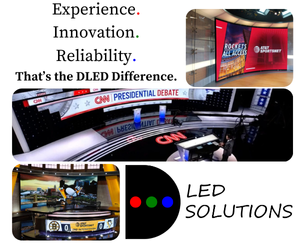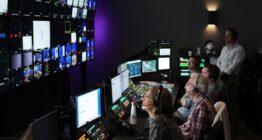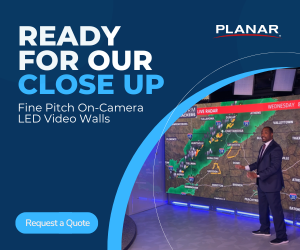Industry Insights: Balancing efficiency and creativity in studio robotic camera systems

Subscribe to NCS for the latest news, project case studies and product announcements in broadcast technology, creative design and engineering delivered to your inbox.
In this Industry Insights roundtable, we explore the impact of camera robotics in broadcast production. Industry experts discuss the benefits, challenges, and future trends of implementing advanced robotic systems in studios.
From enhancing efficiency and creativity to revolutionizing camera movements, our panel delves into how this technology reshapes the broadcast landscape. The discussion covers technical considerations, skill requirements, and best practices for seamlessly integrating robotics with traditional manual operations, offering valuable insights for broadcasters looking to elevate their productions.
Key takeaways from the Industry Insights roundtable
- Camera robotics significantly improve efficiency and productivity in broadcast studios, allowing a single operator to control multiple cameras and create dynamic shots quickly.
- Robotic systems enable the capture of unique angles and movements that would be difficult or impossible with manual camera operation, enhancing creative possibilities.
- While implementing robotics can present technical challenges, proper training and safety protocols are crucial for successful integration.
- The adoption of camera robotics is reshaping production team roles, requiring new skillsets and offering opportunities for more creative positions.
- Future trends in broadcast robotics include increased integration with AR/VR content, AI-driven movements, and seamless scalability across multiple studios and locations.
What are the key benefits of incorporating camera robotics in broadcast productions?
Karen Walker, VP of camera motion systems, Ross Video: The main benefit of robotics is minimizing the number of people needed to operate cameras. Now, a single operator can control multiple robots from anywhere in the world. From a studio perspective, this translates to better ROI and efficient studio utilization, allowing for quick responses to breaking news.
Michael Cuomo, VP, Telemetrics: Robotic Camera Control enables a production studio to capture shots they couldn’t get with a manual camera position, like with our TeleGlide ceiling- or floor-mounted track systems. It’s all about improving the efficiency, flexibility and reliability of a wide variety of production operations. With robotics a single operator can touch a few buttons and create unique on-air looks very quickly.
Paddy Taylor, head of broadcast solutions, MRMC: Camera robotics were originally designed to solve three problems: create consistent, repeatable shots; put cameras where camera operators couldn’t go and reduce costs. Over the past seven to eight years a fourth advantage has developed and that’s creating shots that couldn’t be achieved with manual solutions, such as cable suspended flying shots, or ceiling mounted rail movements. Media organizations are also seeking technologies that not only improve production quality but also save valuable studio space.
James Eddershaw, managing director, Shotoku UK: There are several, with smoothness, precision, and consistency of live on-air camera motion typically the main drivers. Cost efficiency is also important too, especially in a 24/7 operation in which so many of today’s major broadcasters operate.
Neil Gardner, senior product manager for robotics, Vinten: One of the key benefits of cameras is that they improve efficiency and productivity, allowing for faster, more accurate, and reliably repeatable program production. Creative shots are executed without the need for interpretation by an operator moving the camera. Instead, they are pre-programmed to the requirements of the Creative Director and repeated exactly the same way each time. Camera robotics also allows for remote operation of cameras.
How do camera robotics systems enhance the ability to capture dynamic angles and precise movements?
Michael Cuomo: Since robotic systems are made with ultra-precise servo mechanical motors, AI-assisted control software and built-in safety sensors, shots are easily stored and repeatable upon command. Productions can then use those types of shots live on air, and users don’t have to worry about a shot landing wrong or inaccuracies caused by human error. This precision and programmable repeatability are also ideally suited to virtual sets and augmented reality workflows.
Paddy Taylor: Robotic arms such as MRMC’s StudioBot provide highly repeatable movement and when paired with an LED wall, allows for more graphic presentation than ever before. Camera robotic arms are key in delivering improved quality of out-put. For example, when suspended from the ceiling, the robotic arm can reach any point in the studio traversing axes and facilitate spectacular tracking shots with jolt-free image sequences.
James Eddershaw: Placing the camera in a location that would be difficult or impossible for a traditional camera support system is the obvious benefit, however beyond that, consistency of movements is also key. A movement may be a simple pan to the left or right, or a complete 6-axis on-air transition across a studio, but in every case the system will repeat the move time and time again with the same precision and smoothness every time.
What are the technical challenges in implementing advanced camera robotics systems in broadcasting?
Karen Walker: The main challenge is managing the payload on the robotic system, including the camera, lens, prompter, and talent monitor. Camera bodies are becoming smaller, with many customers seeking a shallow depth of field using traditional cine cameras in studio environments. Balancing these cameras with ENG or cine-style lenses can be difficult.
Paddy Taylor: The operation should be carefully managed. One operator can’t control five cameras well if a director is calling for lots of shots, manual cameras have a one-to-one ratio so consider what is realistic. Safety is also crucial. Ensure that safety protocols are effectively documented and enforce training with all those who work within the vicinity of a robotic system and budget for appropriate safety hardware.
How do camera robotics impact the roles and skillsets required within broadcast production teams?
Karen Walker: Traditionally, robotics were seen as a threat to manual camera operators. Now, operators can leverage their skills to obtain the best image using robotics, enjoying greater flexibility and features for perfect shots. The ability to edit or change sequences during a move allows for creative shots, making shows more engaging. Once perfected, these moves can be reused by any operator or even automated systems, ensuring consistency.
Michael Cuomo: Camera robotics enables production teams to take personnel that are performing more mundane tasks and move them into more creative roles. So, instead of having an operator staring at the camera for an hour during a production, they can be using their trained eye to be a robotics control panel operator and get more dynamic results. In this way, it also brought new value to the station’s personnel.
Paddy Taylor: Fifteen years ago, everyone worried that robotics were going to take the jobs of manual camera operators. More often than not, robotics allow more cameras to be used in a studio than would have been possible with manual operators, which adds to the creativity of the show. However, there is a lack of knowledge and experience in this space and it’s vital that the camera operators of the future are given access to training to gain the skills they need.
James Eddershaw: Robotics systems can be implemented with a dedicated operator, or multiple operators, or it may be run in a fully automated environment with no dedicated operator at all. In most cases we see, there is a single operator covering 4-5 robotic cameras using a control system like TR-XT. In a busy production the operator may not have any other responsibilities during the live broadcast, however in many cases the control system is such that it is perfectly possible for the camera operator to also manage camera shading and perhaps lighting too.
Neil Gardner: Advanced robotic camera systems enhance accessibility, allowing less experienced operators to achieve results similar to veterans of the industry. By automating the control of the camera robots and simplifying their use, it frees up the operator to assist with other tasks in the control room, further increasing production efficiency.
What are the potential limitations or drawbacks of relying heavily on automated camera systems?
Karen Walker: A common concern is power outages; manual control provides some movement in such cases, but camera power and prompters remain a concern. If a robot needs maintenance, others can replace it easily, allowing the show to continue.
How can broadcasters ensure that the use of camera robotics enhances, rather than detracts from, the storytelling?
Karen Walker: Camera robotics should enhance storytelling by allowing directors to request specific shots that robotic operators can achieve. Set designers incorporate robotics to complement the storytelling process.
Michael Cuomo: The nice thing about camera robotics is that they are traditionally smaller than their manual equivalent. So, depending upon the shot they are trying to get, the manual cameras are somewhat limited in movement. Robotics help tell better stories on air by incorporating more strategically placed cameras, which can be cost prohibitive with manual cameras.
James Eddershaw: It’s all about the viewer not being consciously aware of the cameras or their movements. However clever the robotics are or how impressive the graphics and set design, TV news is not entertainment and maintaining that distinction is important for our customers. This certainly doesn’t mean having no movement of cameras, but move them smoothly, appropriately, to add to the production value and enhance the story telling.
What are the best practices for integrating camera robotics with manual camera operation seamlessly?
James Eddershaw: Many productions will use mostly robotic cameras, but will maintain the ability to use a manual camera either simultaneously, or during special productions. A decision to make use of robotics should not be a one-time thing. Good robotics will allow complete manual override with no impact on the operation in a manual mode.
Neil Gardner: Many production studios require flexibility, using manual camera operation for some productions, and robotic cameras for others. The most versatile camera robotics offer the flexibility to switch between manual and robotic operation, and when users operate them in manual mode, they feel and behave the same as a pure manual equivalent. These will incorporate pressurised columns, pan-bars and manual lens controls to ensure that the manual camera operator is fully familiar with the operation of the system.
How do camera robotics systems compare to traditional manual camera operation in terms of efficiency and creative control?
Michael Cuomo: The robotic control panel offers a lot of creative possibilities that include recording desired moves and playing them back to performing keyframe and other nonlinear moves. Our reFrame Facial and Object tracking software allows users to feel as if they were behind a traditional camera. Therefore, a robotic camera system gives you more features to be a lot more creative with your productions.
Paddy Taylor: The key difference is where the camera is controlled from. The remote panel could be in the next room, or it could be in a different time zone. Operators need to get their head around this, and we often recommend a wide overview camera is used to give positional understanding to operators when live “joysticking a camera.”
James Eddershaw: A good robotics system will not limit the creative control. The level of overall production automation applied to the robotic (and other) systems may mean that last-minute changes in the production might be more challenging, but that’s a function of the automation constraints not the robotics directly. A well configured robotics system with appropriate balance of automation and human operator override will be prepared for all eventualities.
Neil Gardner: Camera robotics combine very well with AR/VR content, and the precision of robotics aids the final illusion being created. Automating much of the camera movement provides for more angles, more options and better integration. For example, synchronizing camera moves for some subjects from different angles. Without automation and robotic camera positions, creativity is ultimately limited by the number of people available for all these additional operational tasks — it just becomes too much to do without technology assistance.
What are the future trends and predictions for the use of camera robotics technology in broadcasting?
Michael Cuomo: The trend is moving towards a blending of the robotics with the physical set. Stations are increasingly showing wide shots of studio technology when they go to a break. With today’s robotic systems, it’s no longer enough to be functional, they also must look good on air.
James Eddershaw: The main trend is for more advanced motion control — creating camera angles and on-air movements that enhance the production, and would be difficult or cost prohibitive to achieve in any other way. Scalability — bigger and bigger systems, consisting of smaller systems joined seamlessly with full interoperability across studios, sites and cities. This requires the ability to rapidly reconfigure large systems to adapt to studio uses.
Neil Gardner: AI and machine learning will enable robotics cameras and automation to move to the next level. Achieving a natural look at camera movement and framing is key, and that comes with experience. In terms of camera robots, this is achieved through the use of AI to learn and predict how presenters move.
Subscribe to NCS for the latest news, project case studies and product announcements in broadcast technology, creative design and engineering delivered to your inbox.








tags
James Eddershaw, Karen Walker, Michael Cuomo, MRMC, Neil Gardner, Paddy Taylor, Ross Video, Shotoku, Shotoku Broadcast Systems, Telemetrics, Vinten
categories
Camera Control & Camera Robotics, Heroes, Industry Insights, Voices